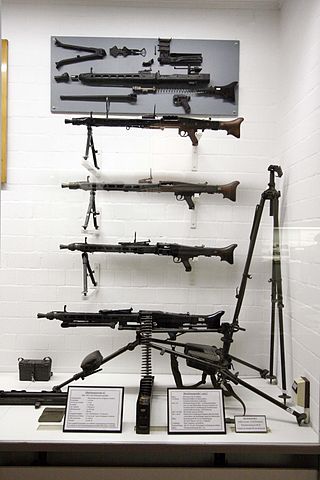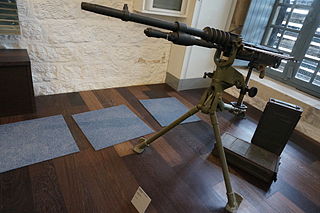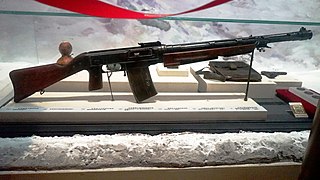
A general-purpose machine gun (GPMG) is an air-cooled, usually belt-fed machine gun that can be adapted flexibly to various tactical roles for light and medium machine guns. A GPMG typically features a quick-change barrel design calibered for various fully powered cartridges such as the 7.62×51mm NATO, 7.62×54mmR, 7.5×54mm French, 7.5×55mm Swiss and 7.92×57mm Mauser, and be configured for mounting to different stabilizing platforms from bipods and tripods to vehicles, aircraft, boats and fortifications, usually as an infantry support weapon or squad automatic weapon.

The Karabiner 98 kurz, often abbreviated Karabiner 98k, Kar98k or K98k and also sometimes incorrectly referred to as a K98, is a bolt-action rifle chambered for the 7.92×57mm Mauser cartridge. It was adopted on 21 June 1935 as the standard service rifle by the German Wehrmacht. It was one of the final developments in the long line of Mauser military rifles.

The Bren gun was a series of light machine guns (LMG) made by Britain in the 1930s and used in various roles until 1992. While best known for its role as the British and Commonwealth forces' primary infantry LMG in World War II, it was also used in the Korean War and saw service throughout the latter half of the 20th century, including the 1982 Falklands War. Although fitted with a bipod, it could also be mounted on a tripod or be vehicle-mounted.

A battle rifle is a service rifle chambered to fire a fully powered cartridge.

The MG 3 is a German general-purpose machine gun chambered for the 7.62×51mm NATO cartridge. The weapon's design is derived from the World War II era MG 42 that fired the 7.92×57mm Mauser round.

The Mle 1914 Hotchkiss machine gun chambered for the 8mm Lebel cartridge became the standard machine gun of the French Army during the latter half of World War I. It was manufactured by the French arms company Hotchkiss et Cie, which had been established in the 1860s by American industrialist Benjamin B. Hotchkiss. The gas-actuated Hotchkiss system was first formulated in 1893 by Odkolek von Ujezda and improved into its final form by Hotchkiss armament engineers, American Laurence Benét and his French assistant Henri Mercié.

The 7.92×57mm Mauser is a rimless bottlenecked rifle cartridge. The 7.92×57mm Mauser cartridge was adopted by the German Empire in 1903–1905, and was the German service cartridge in both World Wars. In its prime, the 7.92×57mm Mauser cartridge was one of the world's most popular military cartridges. In the 21st century it is still a popular sport and hunting cartridge that is factory-produced in Europe and the United States.

The SIG MG 710-3 is a Swiss 7.62 mm general-purpose machine gun (GPMG) designed and manufactured by SIG - Schweizerische Industrie Gesellschaft. The weapon was developed as a commercial venture primarily for export, since the Swiss Army had already adopted the 7.5 mm MG 51 GPMG, produced by the federal arms factory W+F.

Zastava Arms is a Serbian manufacturer of firearms and artillery, based in Kragujevac, Serbia. In 1853, it was founded, and cast its first cannon. It is the leading producer of firearms in Serbia and is a large contributor to the local defense industry. Zastava Arms produces and exports a wide variety of products to over forty countries, including the Zastava M70, a Kalashnikov rifle.
Ludwig Vorgrimler is the man most commonly associated with the design of the Spanish roller-delayed CETME rifle, and its prolific offspring from the German gunmaker Heckler & Koch such as the G3, HK21, P9 and MP5.

The 7.92×33mm Kurz is a rimless bottlenecked intermediate rifle cartridge developed in Nazi Germany prior to and during World War II, specifically intended for development of the Sturmgewehr 44. The ammunition is also referred to as 7.9mm Kurz, 7.9 Kurz, 7.9mmK, or 8×33 Polte. The round was developed as a compromise between the longer 7.92×57mm full-power rifle cartridge and the 9×19mm Parabellum pistol cartridge.
The 7.62×51mm CETME round is a variant of the 7.62×51mm NATO rifle cartridge with a plastic-cored lead bullet and a reduced propellant charge. The 7.62×51mm CETME is otherwise identical to the NATO standard. It was produced as a joint venture by the Spanish Government design and development establishment known as CETME and the German arms manufacturer Heckler & Koch.

The SIG KE7 is a light machine gun designed and manufactured in Switzerland in the decade before the Second World War. Although exported, it was never used by the Swiss Army.

The Fusil ametrallador Oviedo is a Spanish copy of the ZB vz. 26 and ZB vz. 30 Czechoslovak light machine guns.

A fully powered cartridge, also called full-power cartridge or full-size cartridge, is an umbrella term describing any rifle cartridge that emphasizes ballistic performance and single-shot accuracy, with little or no thought to its weight or recoil. They often have a caliber comparable to or greater than 7.5 mm (0.30 in) and a maximum effective range of at least 800 m (870 yd), and are intended for engaging targets beyond 300 m (330 yd). However, cartridges with calibers as narrow as 6.5 mm (0.26 in) have been described as being a full-power rifle cartridge. The term generally refers to traditional cartridges used in machine guns and bolt action and semi-automatic service rifles and select fire battle rifles prior to, during, and immediately after the World Wars and into the early Cold War era, and was a retronym originally made to differentiate from intermediate-power rifle cartridges that gained widespread adoption into military service after World War II.
















